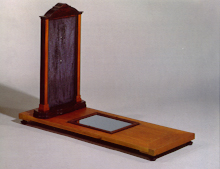
32 x 92 x 35.5
Sculpted wood and metal sheet
INDEX 1788 : Y.I.II.371
Tabula lignea, in cujus medio positum est speculum planum. In aequalibus a medio speculi ditantiis super tabulam imponuntur duae bases ligneae duabus parastatis munitae, in quarum sulcis inseruntur duae laminae ferreae ita perforatae, ut per alterius foramen ingrediantur lucis radii, et a speculo reflexi axeant per alterius foramen: ad ostendendum angulum Reflexionis lucis aequalem esse angulo Incidentiae.
Wooden table in the middle of which a flat mirror is placed. At equal distances from the middle of the mirror on the table two wooden bases are placed, equipped with two columns in the grooves of which two iron perforated blades are introduced so that rays of light enter through the opening of one, and exit reflected by the mirror through the opening of the other; to show that the angle of the reflection of light is equal to the angle of incidence.
The two accessories shown belong to a group of three pieces used for the experimental study of the laws of the reflection of light. One of the pieces is a horizontal wooden board with a flat mirror installed in the middle of the board. The other accessory consists of a metallic plate with two orifices, mounted on a support made of two vertical columns installed on a horizontal base. The third piece, which no longer exists, was a plate identical to that mentioned above.
To perform the experiment, one of the vertical supports with the plate was placed on the horizontal board (containing the mirror) and parallel to the smaller side of it. A beam of light was projected through one of the orifices, so that it would fall upon the centre of the mirror, consequently being reflected. The second support with the perforated metallic plate was placed on the horizontal board parallel to the first and on the other side of the mirror as indicated in the figure below. The position of the supports would be such that the reflected beam of light would reach the second plate, at the height of the orifice of the first. For this to happen, the two supports would have to be equidistant in relation to the point of incidence of the beam of light in the horizontal mirror. Using elementary geometry, it could by proven that the angle of incidence of the beam of light in the mirror and the angle of reflection are the same. This experiment made it possible to show that the incident beam of light and the reflected beam lie on the vertical plane defined by the two orifices through which the light passes and by the point of incidence in the mirror.
From Colégio dos Nobres, catalogue n.° 364.